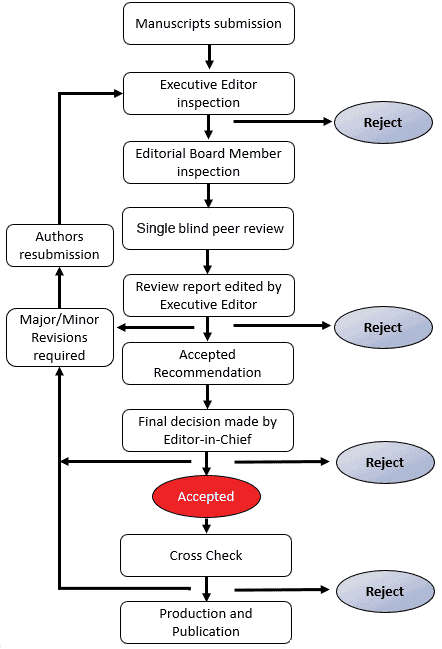Editorial Workflow
BIO Integration uses a single-blind peer review process. Editorial Board Members should organize and conduct a thorough peer-review of a submitted manuscript, to include the scope and the quality of the manuscript.
1. Pre-Check
Once a manuscript is submitted for publication, the manuscript will be reviewed by the editorial office to ensure it is suitable for peer review.
2. Executive Editor or Editors-in-Chief Review
After the pre-check is complete, the manuscript is sent to the Executive Editor of the journal for review.
If the Executive Editor determines that the manuscript is of insufficient quality to go through the normal review process or if the theme of the manuscript is not aligned to the scope of the journal, the Executive Editor has the right to reject the manuscript without further processing.
If the Executive Editor determines that the submitted manuscript is of sufficient quality and falls within the scope of the journal, the manuscript will be assigned to an Editorial Board Member who is familiar with the topic of this manuscript.
Note: If the manuscript is written by the Executive Editor, the manuscript will be handled and inspected by the Editors-in-Chief and vice versa.
3. Peer Review
BIO Integration uses a single-blind peer-review process.
The external reviewers may or may not be from the list of potential reviewers suggested by the authors. The assigned Editorial Board Member reviewer can select at least two reviewers for a particular manuscript depending on the knowledge and experience of the specified reviewers.
A review report provides the Editors with feedback on the quality of the manuscript under consideration. It also supplies authors with explicit insight on how to improve their papers to make them suitable for publication in the journal. Although confidential comments to the editors are not relayed to authors, any remarks that may help improve the quality of the manuscript will be forwarded to the authors for their consideration. Reviewers are expected to provide advice on the following points in their review reports:
- Is the manuscript written comprehensively enough to be understandable? If not, how could it be improved?
- Have adequate proofs been provided for the declarations?
- Have the authors addressed the previous findings fairly?
- Does the paper offer enough details of its methodology to reproduce the experiments?
- BIO Integration encourages authors to publish detailed protocols as supporting information online. Do any particular methods used in the manuscript warrant such as protocol?
The reviewers are expected to provide their reports in a timely fashion (within two weeks) since a prompt review leads to the timely publication of a manuscript which is beneficial not only for the authors but for the scientific community as well.
The reviewers submit their reports on the manuscripts along with their recommendation of one of the following actions to the assigned Editorial Board Member:
- Accept Submission
- Major/Minor Revisions Required
- Decline Submission
4. Editor Decision
The review reports are edited by the Executive Editor if the comments contain confidential information. Reviewers should include such comments in the confidential section of the review form, which is intended to be read by the editors only. If the quality of report from reviewer does not meet the requirements, Executive Editor has the right to ask Editorial Board Member for an additional reviewer.
When all reviewers have submitted their reports, the Executive Editor can make one of the following editorial recommendations to the Editor-in-Chief:
- Accept Submission
- Major/Minor Revisions Required
- Decline Submission
If the Executive Editor recommends “Accept Submission”, the Editor-in-Chief is notified so he/she can inspect the manuscript and the review reports. The Editor-in-Chief can either override the Executive Editor’s recommendation in which case the manuscript is rejected or approve the Executive Editor’s recommendation in which case the manuscript is accepted for publication.
If the Executive Editor recommends “Major/Minor Revision Required”, the recommendation is communicated to the authors. The authors are expected to revise their manuscripts in accordance with the changes recommended by the reviewers and to submit their revised manuscript in a timely manner. Once the revised manuscript is submitted, the original reviewers are contacted with a request to review the revised version of the manuscript. Along with their review reports on the revised manuscript, the reviewers make a recommendation which can be “Accept Submission” or “Revisions Required” or “Decline Submission”. The Executive Editor can then make an editorial recommendation which can be “Accept Submission” or “Revisions Required” or “Decline Submission”. If the Executive Editor recommends rejecting the manuscript, the rejection is immediate. Also, if two of the reviewers recommend rejecting the manuscript, the rejection is immediate.
The editorial workflow gives the Executive Editor the authority to reject any manuscript because of inappropriateness of its subject, lack of quality, or incorrectness of its results; it also gives the Executive Editor similar authority over those manuscripts assigned to them by the Editor-in-Chief. However, only the Editor-in-Chief can approve a manuscript for publication, whereas Executive Editor recommend manuscripts for acceptance to the Editor-in-Chief. Recommendation of acceptance has to be approved by the Editor-in-Chief first before publication. The Executive Editor cannot assign himself/herself as a reviewer of the manuscript. This is to ensure a high-quality, fair, and unbiased peer-review process of every manuscript submitted to BIO Integration, since any manuscript must be recommended by one or more (usually two or more) external reviewers, an Executive Editor, and the Editor-in-Chief before acceptance for publication.

Conflict of Interest
BIO Integration respects requests not to have manuscripts peer-reviewed by those experts who may have a competing interest with the author(s) of a submitted manuscript. It is not possible for Editors to be aware of all competing interests; we therefore expect that reviewers inform the Editor-in-Chief or the Executive Editor if they notice any potential competing interest during the course of review of a manuscript. Moreover, the reviewers are expected to inform the Editors or editorial office of the journal if they have a conflict of interest in carrying out a review of a manuscript submitted by any author/contributor of the manuscript.
Special Issues
Special Issues (SIs) are collections of papers centered around a subject of special interest and are organized and led by subject experts who take on the role of Guest Editor of the Special Issue. All submissions follow the same peer review process as regular papers. All papers will be submitted through the journals on-line submission system and Guest Editors and invited authors must follow all journal Editorial Policies carefully.
BIO Integration is indexed in Scopus, CAS, DOAJ, Research4Life, Ulrich’s web, OCLC, WorldCat, Primo Central (Ex Libris), Sherpa Romeo and Summon Databases.










